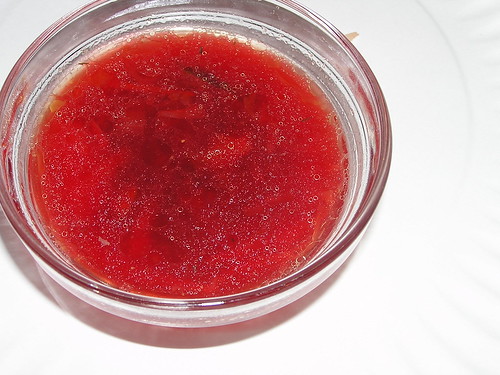russian borscht
Sometime last week, I felt the inspiration to cook and toss all my daily tasks to the wind. I suspect that sudden burst of energy and desire were prompted more by the cold weather and bone-chilling wind than by anything else. My mother, one of the best soup makers I know, happens to have an amazing borscht recipe under her belt. And when seasons shift definitely colder, borscht is one of the soups, along with Russian cabbage soup (schi) that I turn to.
Many an American has wrinkled his nose when a beet is introduced into a conversation. Growing up in suburban America, I was always defending the virtues of root vegetables: turnips, carrots, beets, radishes. Because I was an immigrant, my food preferences were considered strange at best, and disgusting at most. And I grew up thinking that not only beets were uncool (albeit tasty), but they were also a form of lower-income diet. Imagine my surprise when my monthly issue of Martha Stewart Living arrived (I must have been the only 16-year old with a MSL subscription) and I found a salad of beets and chevre beautifully displayed as one of the recipes. Either beets were gaining ground or Martha was going back to her Polish roots. Either way, beets were comin’ up!
These days, you will find beets in the most illustrious of restaurants. They’re tucked into salads, displayed in vegetable arrangements, cooked in soup, and hidden in chocolate cake. Their deep, rich color and sweet earthy flavor and texture are both filling and surprisingly light. They smell of the earth, of winter, and of home. And despite their lowly upbringing and modest looks, they’re quite elegant and sophisticated.
Borscht is a little bit of a commitment. Set aside a few hours over a weekend to make it if only because you want the flavors to gradually develop. Deeper flavor means more delicious borscht. To make up for taking its time, borscht is not a complicated soup to make. And as most soups often do, borscht tate better the next day. If you make this soupd with beef, it’s a meal in and of itself. Russians often serve it as a first course at dinner, but in smaller portions. Whichever way you choose to eat it, borscht is guaranteed to make this winter season a little more palatable.
One (3 pound) lean beef brisket, trimmed of remaining fat
2 cloves garlic, finely chopped
1 large onion, diced
3 plum tomatoes, diced
2 carrots
3 celery stalks
2 cups shredded cabbage
4 small beets
3 quarts beef/chicken/vegetable stock
1 cup sauerkraut
Kosher salt
Freshly ground black pepper
Sugar, to taste
Chopped fresh dill for garnish
1. Wash and cut beets in half. Place on a roasting pan, pour half a cup of water and cover with foil. Roast at 350F for 25 minutes or until beets are soft to pierce with a knife.
2. When the beets are done, pull the out and set aside to cool.
3. Place the meat on a roasting rack and roast for 15 minutes at 350F. This is great for bones – improves their flavor.
4. Meanwhile, in a sauté pan, sauté finely chopped garlic and diced onions. Add 3 tsp salt.
5. Add in tomatoes, celery and carrots. Continue to sauté until the vegetable medley gets softer and more translucent.
6. When the meat is done, pull it out and place in a stock pot. Add the stock and bring to a boil. Remove any foamy whiteness that forms while the water is boiling.
7. Add the vegetable medley to the pot.
8. Grate the beets with a coarse grater and add to the pot.
9. Add the cabbage and the sauerkraut. If you feel that you need more liquid to balance the “stuff” in your soup, add some water or more stock, if you have it on hand.
10. Lower the heat and continue to simmer the soup. After half an hour, taste and add salt and pepper to suit your preferences. If needed, add sugar.
11. Simmer for another hour and continue to taste for flavor.
12. Serve with chopped dill as garnish.
This soup can also be made as a vegetarian version. Just omit everything to do with meat and use vegetable stock instead.
Sauerkraut can be easily purchased, however, it can also be easily made. A recipe for a homemade sauerkraut, Russian-style, will appear shortly. Maybe in a few days.

Lorri
I love your stuffed cabbage and came on your site hoping for a borscht recipe to get us through the upcoming winter. Do you have a preference between beef and chicken? Do you have a suggestion for buying beef parts? If I go with chicken, I assume I can just use a cut up roaster, right? Lastly, can I use canned tomatoes? Excited to try this!
Radish
Lorri – yes on canned tomatoes. i prefer either beef or vegetarian though my mom most often makes chicken. if you have good meat, good stock – then everything is delicious!! happy cooking.
Maggi
I am sure if you research, you will find that this recipe is Ukranian Borsch. Russian Borsch has a lot of cream, and not so mant beets, it is very delicious!
olga
Maggi – this is my family recipe. :) And since we’re from Russia I assumed it was Russian.